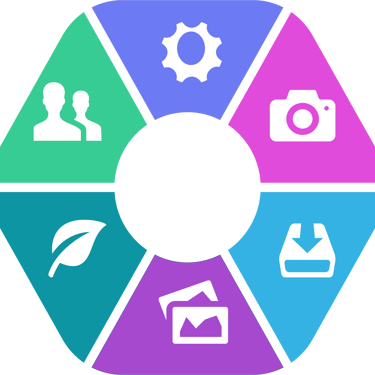My Learning Manifesto: Transform through passion, learn with purpose
As a teacher, educational advisor, and passionate about education, I dream of a digital learning environment that opens pathways, removes barriers, amplifies voices, and embraces diversity. Every learning experience should be designed with the understanding that people learn in many ways. Everyone, including neurodiverse individuals, has the right to an education tailored to their unique needs and capacities. This means integrating tools and strategies that honor their ways of learning and enhance their capabilities (CAST, 2022).
I firmly believe that learning should be built upon strategies promoting engagement, supported by motivating tools and meaningful experiences that spark curiosity and lead to action. In this context, educational design must go beyond content delivery. It must create authentic connections with learners, foster participation, and help develop skills that are relevant to real life (Fullan, 2013). I understand that digital learning goes far beyond using platforms or apps. It is an opportunity to reimagine what we can build together by leading learning processes that inspire, connect, and transform.
My Passion
I’m passionate about witnessing how a spark of curiosity can turn into a flame of deep learning. I’m driven to design educational experiences where every learner has a voice, meaningful choices, and the opportunity to learn purposefully. I’m also inspired to propose educational strategies that encourage others to keep learning, explore new ways of teaching, and integrate technology with intention. I deeply believe in the power we, as educators and instructional designers, must create inclusive learning environments, spaces where every resource, activity, or piece of content recognizes diversity and fosters authentic participation. I am motivated to redefine how we present knowledge so that all students, including those with different learning styles or special conditions, can feel included, connect with the content, and find meaning in their learning journey.


Emerging Challenges in Learning and Digital Leadership
At the global, state, and local levels, we face significant challenges that continue to limit educational transformation, including:


The persistence of rote memorization is still present in many school systems instead of promoting 21st-century skills.
Resistance to change in educational leadership prevents the adoption of student-centered models.
The exclusion of neurodiverse populations in developing educational materials tailored to their unique ways of learning.
The superficial use of digital tools without a clear strategy or connection to students’ real and diverse needs.
There is a lack of ongoing, inclusive, and meaningful professional development for teachers, especially in technology's intentional, reflective, and pedagogical use.
The digital divide still excludes students and teachers without equitable access to technological resources.

Although technology has advanced, a pedagogical and inclusive vision gap exists. This remains a significant barrier to achieving authentic, accessible, and equitable learning experiences (Harapnuik, Thibodeaux & Cummings, 2018).
Digital leadership must focus on creating educational cultures rooted in collaboration, innovation, inclusion, and equity, where all learners, including those with neurodiverse conditions, can learn and shine in their own unique ways (CAST, 2022).
Technology with Intention: Hybrid Experiences That Transform
In this constantly changing world, where technology evolves faster than ever, in-person and virtual learning environments are redefined daily. This challenges us as educators to rethink how people learn and how we can design strategies supporting those who process information differently. Learning improves significantly by removing barriers through intentional design and creating flexible, accessible, and personalized environments. Promoting inclusion means recognizing that learning variability is the norm, not the exception. We must envision hybrid experiences integrating active learning stations, multimodal resources, and authentic assessments responding to different learning styles. Fullan (2013) proposes that students should be seen as active partners in learning and that technology should be used to collaborate, solve real-world problems, and build meaningful knowledge. This reinforces the need to design digital learning experiences with intention, creativity, and purpose.


What’s Working and What Needs Improvement in Education
There is a growing global interest in integrating technology into education, not just as a tool but as a catalyst for innovation, personalization, and meaningful learning. Schools are increasingly embracing digital platforms, adaptive tools, and collaborative technologies to support diverse learning needs. At the same time, international initiatives promote 21st-century skills such as critical thinking, creativity, and digital fluency, moving education beyond rote memorization. Another major shift is the recognition of emotional well-being and mental health as essential to student success. This leads to implementing Social and Emotional Learning (SEL) frameworks that nurture empathy, resilience, and positive relationships (CASEL, 2023). These emerging trends signal a hopeful transformation toward more purposeful and human-centered education.
We must humanize digital learning, making students the protagonists, not passive spectators. It is essential to move away from standardized approaches and instead value students' passions, talents, contexts, and neurodiverse ways of learning. Education must listen more closely to learners, understand their realities, and adapt instruction to align with their dreams and unique learning processes. There is also an urgent need to rethink assessment models, which often limit learning instead of supporting it. Traditional testing methods do not always reflect students’ abilities, growth, or real-world potential. Creating inclusive environments means designing flexible strategies and tools that respond to different ways of processing information. All students deserve to feel seen, heard, and empowered. True educational progress happens when purpose, equity, and human connection are placed at the heart of the learning experience.
What’s working:
What needs improvement:
What should the world do to enhance or fix it?

To address these challenges, the world must reimagine the true purpose of education. Learning should not be limited to transmitting knowledge; it should inspire students to think critically, create meaningfully, collaborate authentically, and act purposefully. Schools must become dynamic environments where learning is connected to real life, the community, and social transformation. This requires a shift toward more inclusive and student-centered models, where equity, creativity, and personal voice are central to the design of learning experiences. By embracing frameworks like Universal Design for Learning (CAST, 2022) and the COVA model (Harapnuik, Thibodeaux & Cummings, 2018), we can ensure that all learners—including those with diverse needs—feel empowered, seen, and supported.
My Beliefs About Digital Learning


I believe digital learning should be a meaningful, personalized, inclusive, and purposeful experience. It’s not just about using technological tools but creating spaces where learners feel seen, valued, and motivated to grow through authentic learning.
Technology must serve pedagogy, inclusion, and equity in this context, not vice versa. It’s not about adapting education to fit the tools but about using those tools to enrich teaching, remove barriers, and expand opportunities for all.
I believe that every learning process should amplify student voice, foster autonomy, and encourage authenticity, as promoted by the COVA approach (Harapnuik, Thibodeaux, & Cummings, 2018). Only then can we nurture critical, creative, and empowered learners.
I also believe that real change in education begins when educators feel empowered, supported, and valued. We are agents of transformation, and when we are trusted and equipped, we can lead truly innovative processes.
Digital leadership must be human-centered, empathetic, creative, and future-oriented. Through connection, collaboration, and inspiration, we build an education system capable of meeting the challenges of this era.
Finally, I believe that learning is an act of hope, a way to create social transformation and educational justice. Through purposeful digital learning, we can build a world that is more equitable, accessible, and full of opportunities for all.
Previous Achievements and Innovative Practices
As a teacher and educational advisor in both school and corporate contexts, I have led processes that combine innovation, inclusion, and educational transformation. I have designed and implemented hybrid models centered on learning stations and adaptive assessment, tailored to meet the diverse needs of students. These models promote active participation, critical thinking, and personalized learning.
I have also developed accessible digital resources and strategies to integrate technology intentionally into teaching, ensuring it serves pedagogy rather than being just a technical tool. I have participated in the design, implementation, and evaluation of an educational and pedagogical model for a company, actively supporting the review of instructional designs in face-to-face, virtual, and digital formats.
In the corporate setting, I support the creation of educational strategies for adult learners with the goal of improving their well-being, helping them manage risks, strengthening their professional growth, and increasing their competitiveness in healthy work environments.
With my second-grade students, I am actively working on integrating technology as an essential part of their learning experiences. Through playful, creative, and digital activities, I promote the development of 21st-century skills from an inclusive, transformative, and human-centered perspective.








A Manifesto for Educators Who Transform: Designing with Purpose, Teaching with Heart

This manifesto comes from the voice of an educator who deeply believes in the transformative power of teaching. It addresses you: teacher, instructional designer, educational leader, or organizational trainer who longs for more human, inclusive, authentic, and learner-centered learning environments. It is also intended for pedagogical teams in educational institutions and corporate organizations that wish to integrate technology not as an end but as a means to empower all learners, especially those with diverse learning styles or special needs.
I’ve created this manifesto as a living guide that can:
Inspire pedagogical innovation, especially in virtual or hybrid settings.
Support instructional design decisions with an empathetic, inclusive, and transformative lens.
Serve as a starting point for meaningful conversations about equity, technology, diversity, and education with purpose.
Beyond the personal, my intention is to plant a seed in the educational community a seed of change, collaboration, and commitment. I hope this manifesto motivates us to create, adapt, and share resources that respond to the realities of all learners. Together, we can build learning environments where teaching is filled with love, curiosity is awakened, and learning becomes a lifelong journey.



References
CAST. (2022). Universal Design for Learning Guidelines version 2.2. https://udlguidelines.cast.org/
CASEL. (2023). What is SEL? https://casel.org/fundamentals-of-sel/
Fullan, M. (2013). The new pedagogy: Students and teachers as learning partners. https://michaelfullan.ca/wp-content/uploads/2016/06/13396088160.pdf
Harapnuik, D., Thibodeaux, T., & Cummings, C. (2018). Developing a Significant Learning Environment. https://www.harapnuik.org/?page_id=7984
Harapnuik, D., Thibodeaux, T., & Cummings, C. (2018). Developing a Significant Learning Environment. https://www.harapnuik.org/?page_id=7984
